How to Amplify Your Content Strategy Using SMEs and Influencers
You don’t need a 10-person team or a six-figure budget to publish content your audience actually trusts. You need a system. One that turns subject matter expertise into a repeatable engine for blogs, reports, social posts, and more, without burning out your team or ghosting your contributors. This article breaks down exactly how to do it, using a playbook that’s simple, scrappy, and built for the way real teams work.

You’ve got 17 tabs open. One’s a Google Doc for your next newsletter. Another’s an email thread with a subject matter expert who just asked to “circle back next month.” And in Slack, someone’s wondering if that influencer you partnered with last quarter ever shared the post.
This isn’t a strategy. It’s survival.
Alex Lieberman gets it. In his 2025 marketing playbook, he outlines a streamlined, 11-step strategy that offers a clear, bare-bones system built for action.
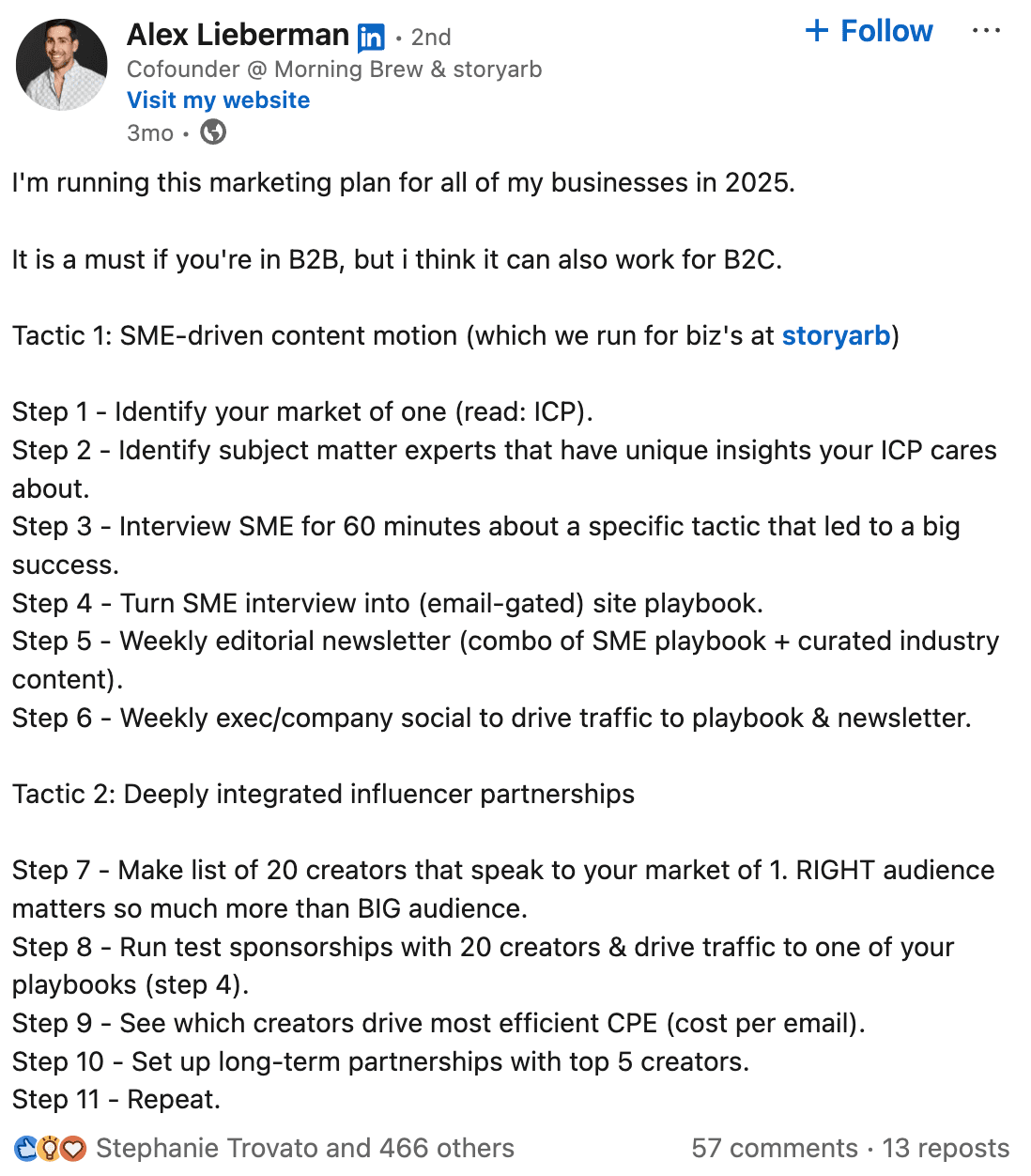
It’s grounded in something 54% of marketers are struggling with right now: resource constraints.
Instead of chasing shiny tactics or stacking more tools, it gives you a clear, low-lift way to consistently publish expert-driven content that moves the needle, without a huge team or budget.
In this guide, we’ll walk through how to put Alex’s framework into practice. By the end, you’ll have a simple, repeatable system for building trust with your audience and your stakeholders.
Start with the right target: Define your ideal customer profile (ICP)
Before you start looking for SMEs or influencers, you need to conduct audience research to know exactly who your content is for.
Your ideal customer profile (ICP) — a clear description of the companies and people you’re trying to reach — gives your team a common lens to evaluate content fit and select credible voices your audience already trusts.
It answers:
- What does our audience care about?
- Whose voice will they trust?
- What topics are most urgent and useful to them right now?
Here’s a quick template to help you build an actionable ICP:
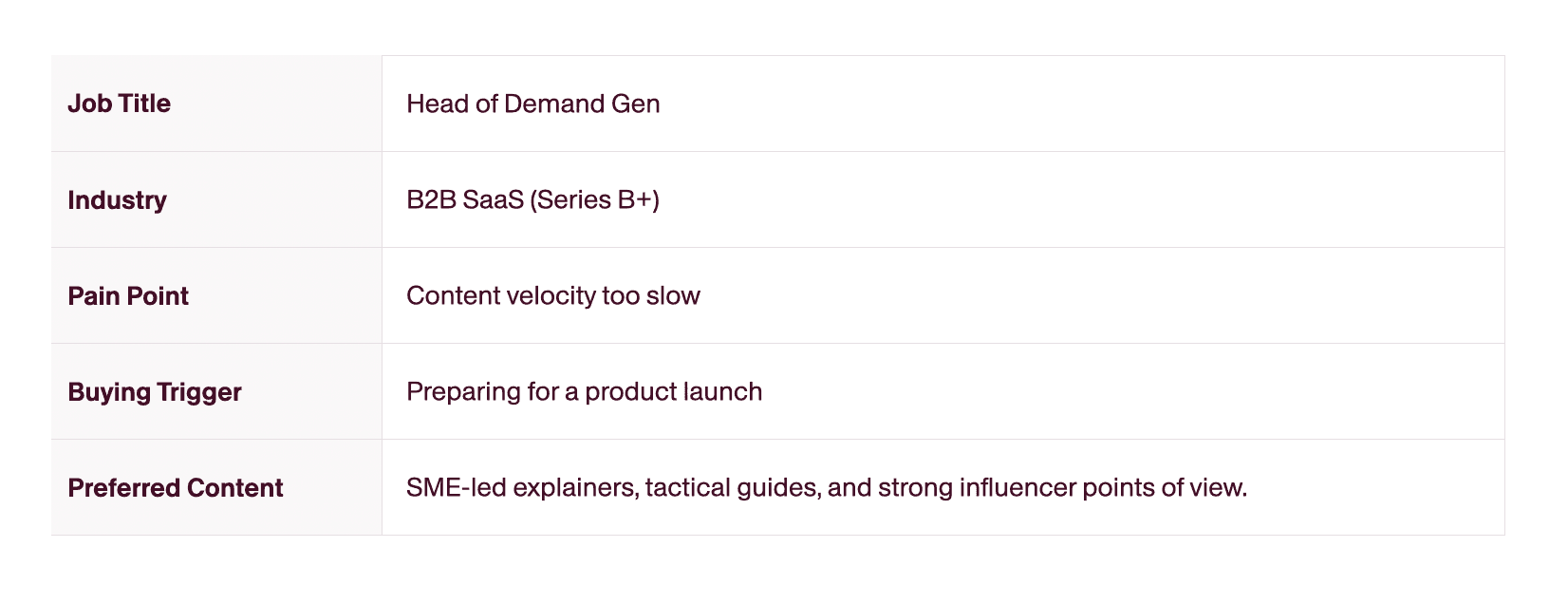
When your team aligns on your ICP, you can more easily identify SMEs and influencers who already resonate with that audience, making your outreach more efficient and your content more relevant.
Find SMEs quickly — without the headaches
According to The Content Studio’s report, The State of (Dis)Content, almost 50% content marketers say accessing subject matter experts is one of their biggest challenges. And if you’ve ever spent hours combing through LinkedIn or lurking in Slack groups, you know exactly why.
Instead of building a massive outreach list, use a three-part filter:
- Topical credibility — they’ve done the thing recently.
- Audience relevance — their voice resonates with your ICP.
- Format fit — they’re comfy in your content style (Q&A, async, quotes).
Ryan Prior, Head of Marketing at influencer marketing platform Modash, cuts straight to the point. “We simply look for the most qualified people to comment on a particular topic,” he says.
For a piece on food influencer marketing, they brought in someone from a food-focused agency. For Instagram briefings, they sourced creators already active in IG collabs.
Modash’s ICP — Shopify brand marketers running influencer programs — is the backdrop. But it’s the credibility-first mindset that keeps their content relevant and efficient to produce. Focusing on fit over fame speeds up production and keeps content laser-targeted.
Here’s a quick playbook to identify your next SME fast:
- Scan LinkedIn for practitioners posting about your topic
- Ask your internal team — product marketing, customer success, and sales — who they trust
- Browse guest lists from niche podcasts or webinars
Find someone whose POV is specific, trusted, and relatable to your ICP.
Co-create the idea before you create the content
If you're putting together a heavy content asset like a research report or in-depth playbook, get alignment before you’ve spent 60 hours building something no one asked for.
That’s why co-creating the idea, not just the final content, is one of the highest-leverage moves in your content strategy.
Tommy Walker, founder of The Content Studio and former Editor-in-Chief at Shopify Plus, knows this firsthand. Before investing time in producing The State of (Dis)Content, he ran a quick litmus test:
“I started reaching out to folks like Jimmy from Superpath, the team at SparkToro, and a few others. I’d say, ‘Here’s the basic idea — this is the log line, here’s what I’m hoping to uncover in the data. If I turn this into a full report, is that something you’d be interested in distributing?”
He didn’t write a single word until he had early validation from high-signal distribution “nodes” — people with both reach and audience alignment.
“I wasn’t going to go through the process of creating some giant lead gen material without validating the idea first.”
Invite SMEs early to create better content and committed distribution partners.
Louise Linehan, Content Marketer at marketing intelligence platform Ahrefs (ex-BuzzSumo), echoes this. When producing data-backed reports at BuzzSumo, her team ran early-stage outreach to trusted experts, sharing rough decks, gathering feedback, and looping contributors in well before launch.
“We learned this from our founders, who involved thought leaders and journalists in the actual creation of the report, taking on their opinions, advice, quotes, research criteria suggestions, and any other ideas, and activated that community on launch day. It led to huge traffic spikes, PR coverage, viral social media engagement, and even directly attributable sales.”
Instead of scrambling for shares after the fact, you create content that’s already wired for distribution (which we’ll get to shortly).
Interview like a pro (and actually use the insights)
The quality of your SME content starts with the quality of the interview. But let’s be honest, a lot of expert interviews yield the same safe, surface-level answers.
Ask better questions, build real rapport, and frame the conversation to pull out the kinds of insights you actually want your audience to see.
Here are some tips from Riviera Lev-Aviv, content writer and strategist:
- Ask about real experiences. Skip “What are your biggest pain points?” and ask, “What was the most frustrating day you’ve had this year — and why?” Emotional memory triggers specificity, which leads to clearer, more relatable insights.
- Leave room for tangents. Schedule more time than you need and don’t rush through the outline. When people stop filtering, they often reveal an unexpected detail or opinion that reshapes your angle.
- Tailor your prompts. Look for something distinctive in their background — a LinkedIn post, hobby, or past role — and connect it to your topic. Find a hobby or unique trait (e.g., a CMO who speaks four languages) and use it to draw a metaphor that gets them thinking differently.
And if you’re looking for interview questions that follow these principles, here are some prompts:
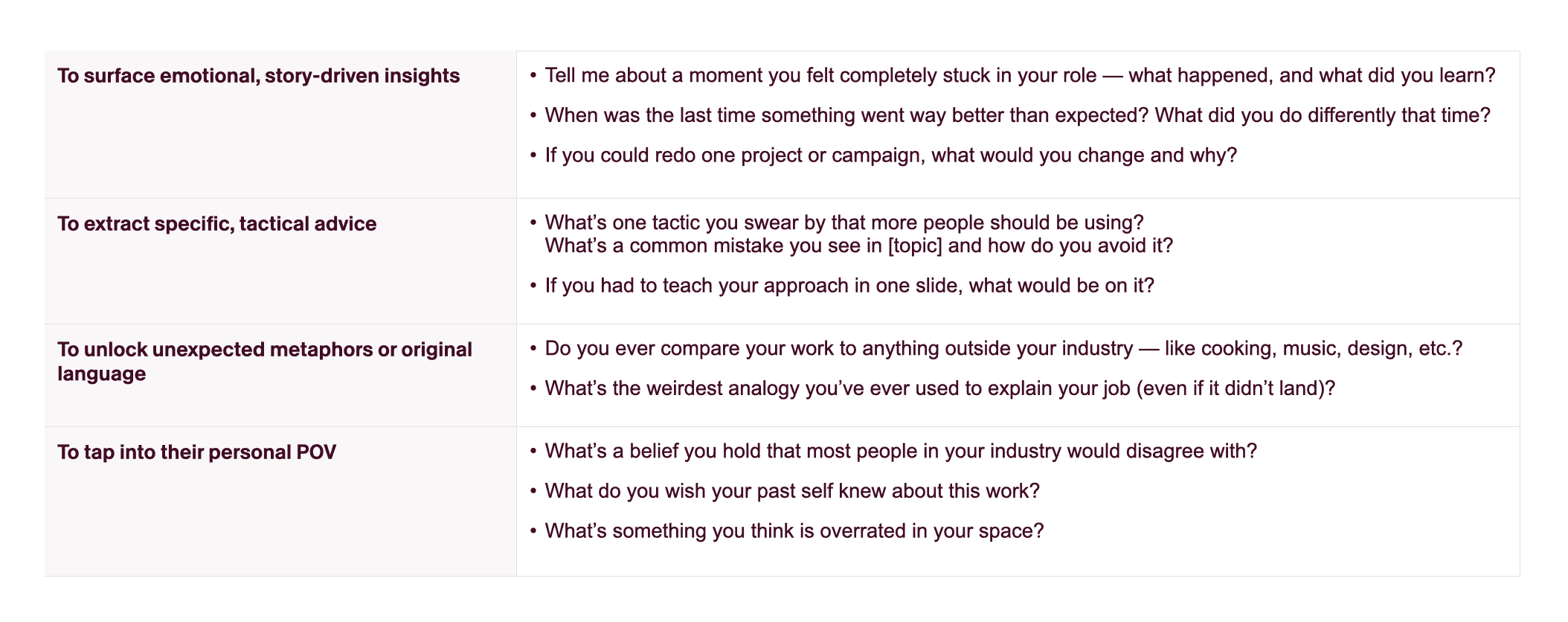
Lastly, document SME insights in a way that makes them easy to repurpose later. Try this stack:
- Otter.ai or Grain to record/transcribe
- Notion to tag standout ideas
- Descript for video and social quotes
- Relato (of course) to store SME transcripts, briefs, feedback, and approvals
With the right questions and a little space to breathe, SME interviews become less like content “gathering” and more like collaborative ideation.
Repurpose SME insights into assets that scale
SME interviews aren’t just a one-and-done tactic. When you structure and organize them right, they can fuel long-form gated content, newsletters, social campaigns, and more without burning out your team.
Here’s how to turn one set of SME insights into multiple, high-impact formats.
Turn SME insights into email-gated content quickly
Gated content playbooks, industry deep-dives, or tactical guides often fall into one of two traps: either they’re bloated and over-polished, or they’re so surface-level that they feel like a blog post behind a form.
But they can also offer both authority and real-world usefulness without requiring months to produce.
Rosanna Campbell, a content strategist who helped create the guide “The New Manager Handbook” for People Managing People, found that starting with SME interviews was the unlock.
“We let the interviews shape the structure. I suggested we make it into a fun, magazine-y guide. It felt valuable enough to gate because I did several, really thorough interviews with true industry experts — senior leadership at places like Lattice and GitHub — and gathered insights you literally couldn't find anywhere else.”
The result: a cohesive, interview-driven guide shaped around hard-won lessons, not arbitrary chapter headers.
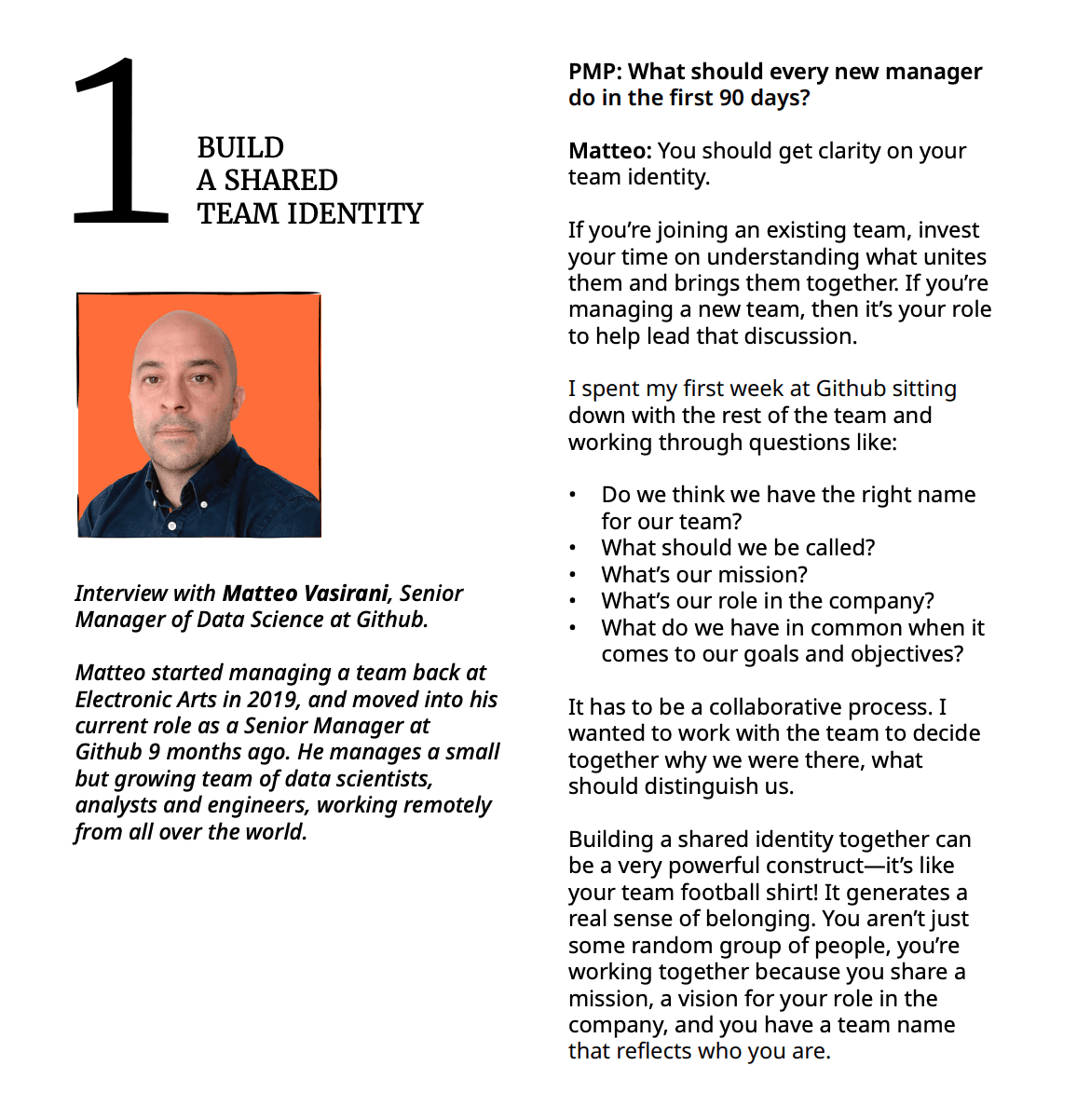
That same insight-first approach works especially well when paired with modular design, formatting that makes SME contributions easy to scan, share, and reuse.
Take Asana’s 2024 State of AI at Work. It translates expert research into a visual framework: structured, digestible, and tightly scoped to a high-stakes topic their ICP cares about.
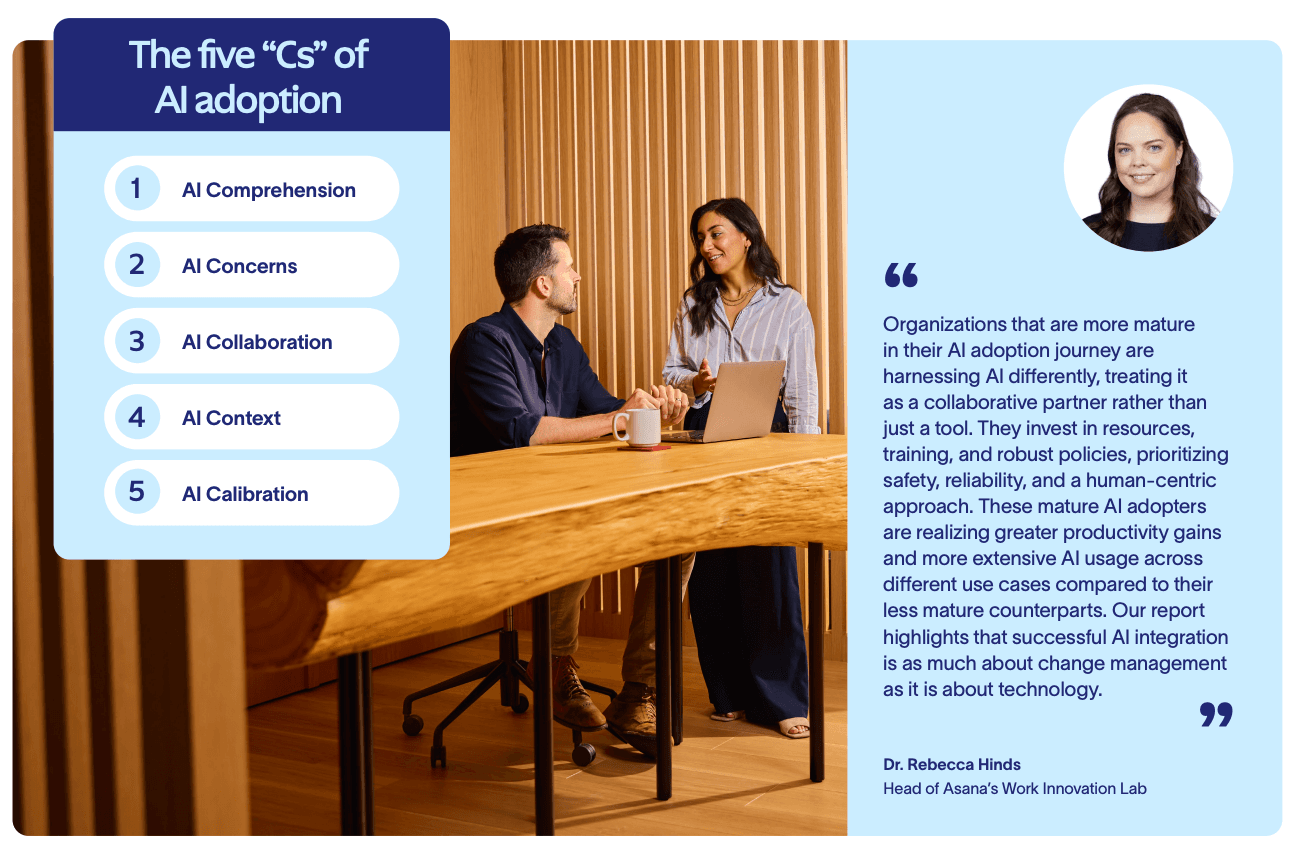
Or look at this snippet from Sprout Social’s 2025 Index report, where each SME quote is treated like a standalone card — snackable, screenshot-friendly, and plug-and-play for launch kits and carousels.
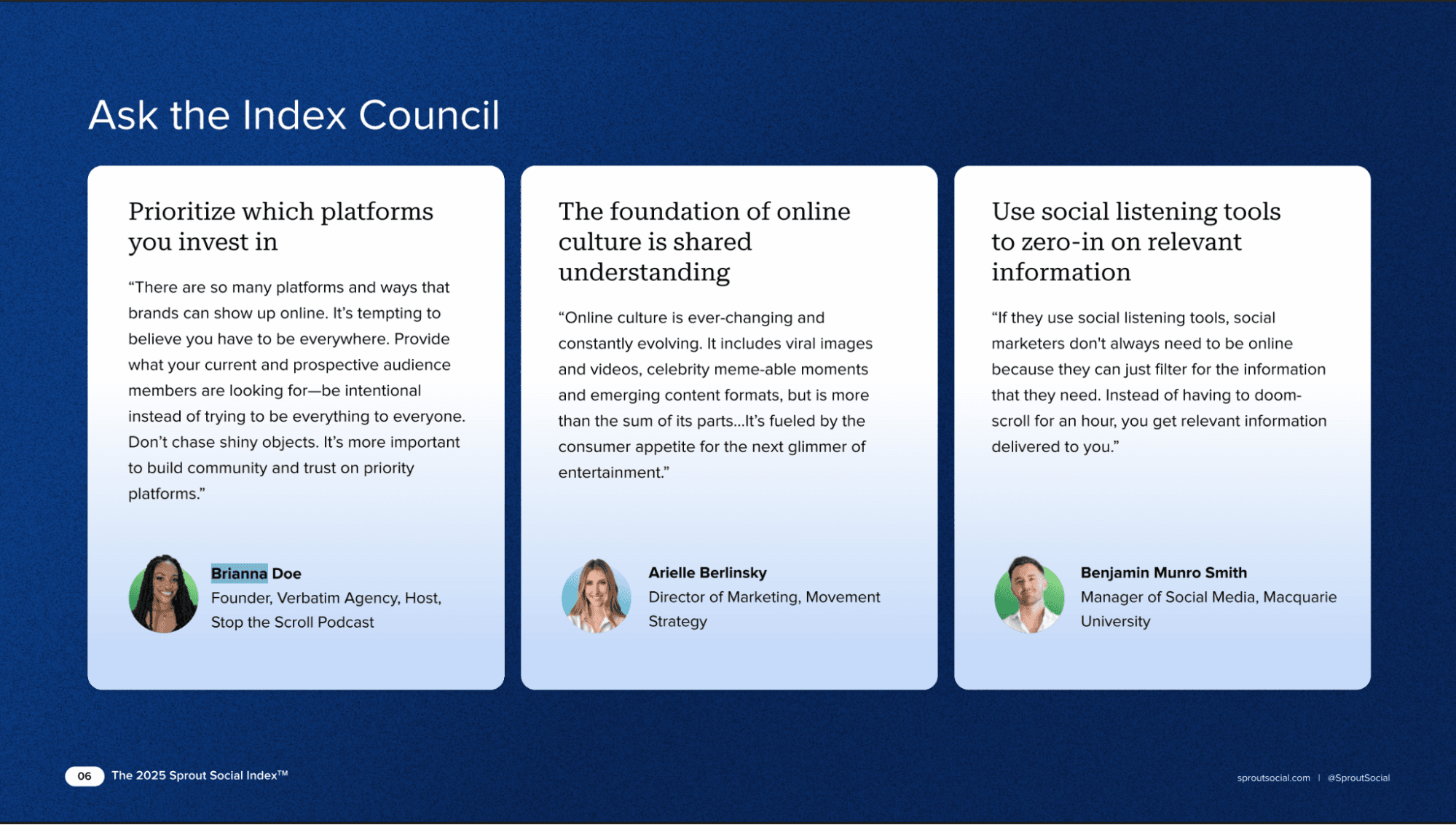
To pull this off without overthinking it:
- Start with three to five SME interviews tied to one high-stakes ICP problem
- Group responses by common themes
- Format each insight as a standalone, headline-driven block
- Use functional visuals (icons, cards) to make scanning easy
- Gate it with a CTA that makes the value crystal clear
When SMEs drive the substance, and structure follows the insight, you end up with a resource people actually want to exchange their email for.
Build a newsletter that writes itself
SME-led newsletters stall out because the raw material isn’t organized: interviews run long, quotes are too broad, and it’s unclear how to package insights into a clear, consistent format.
Repurposed SME insights from blogs, gated assets, customer stories, or webinars are the easiest way to fuel a consistent newsletter without starting from scratch every week.
Eric Doty, Content Lead at Dock, built Dock’s Grow and Tell newsletter by tapping into the brand’s archive of 41+ podcast interviews.
“These hour-long interviews, even if nobody listens to them, are better content fodder than interviewing people for each article,” Eric says. “You just get more interesting stuff when someone can talk for a while and really go deep.”
“You just get more interesting stuff when someone can talk for a while and really go deep.”
Instead of scheduling new interviews for every newsletter, Eric’s team pulls from long-form recordings, structures the best parts, and plans consistent issues.
All Eric needs to do is provide the episode and a basic format:
- Short intro framing the guest/topic
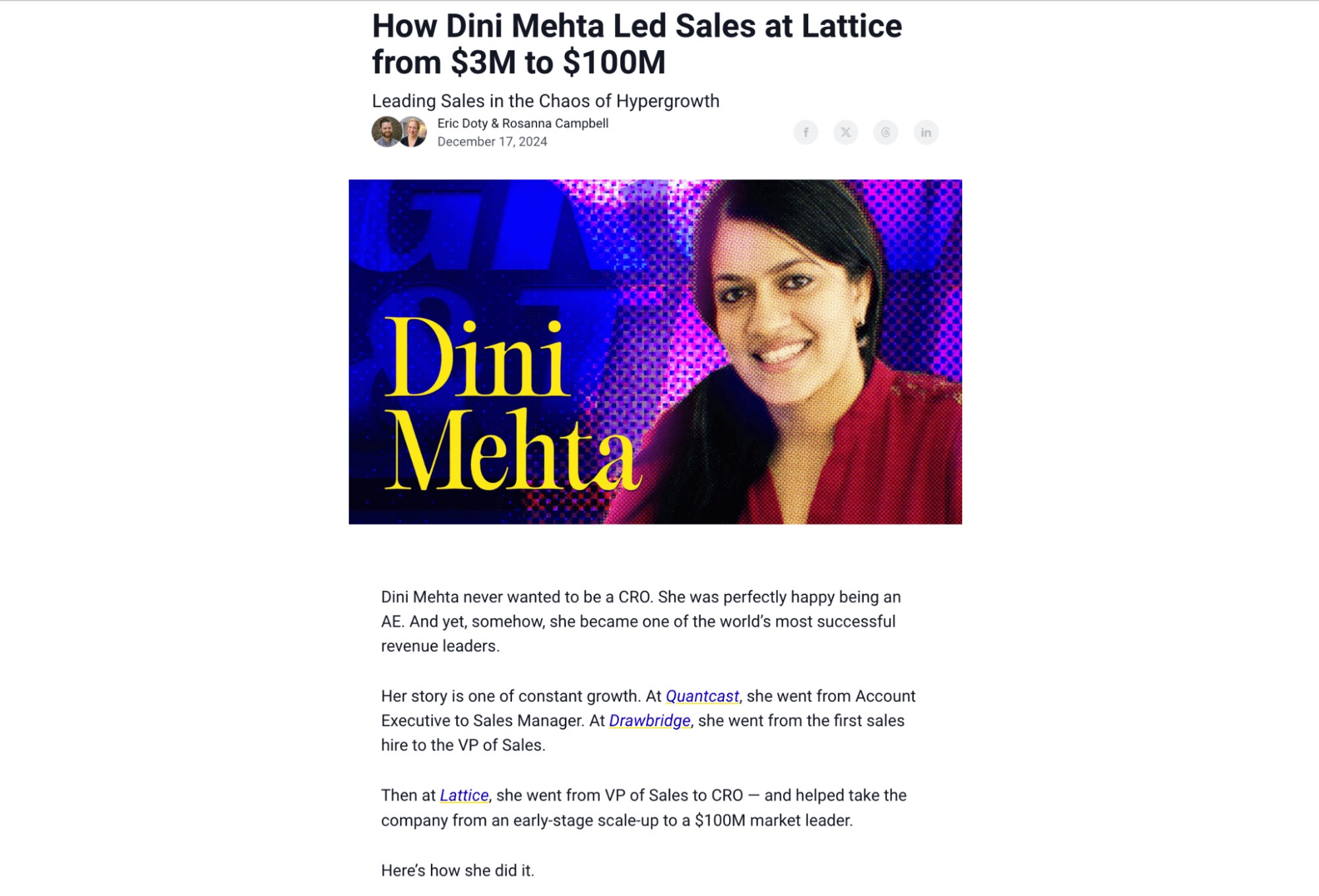
- Key takeaways
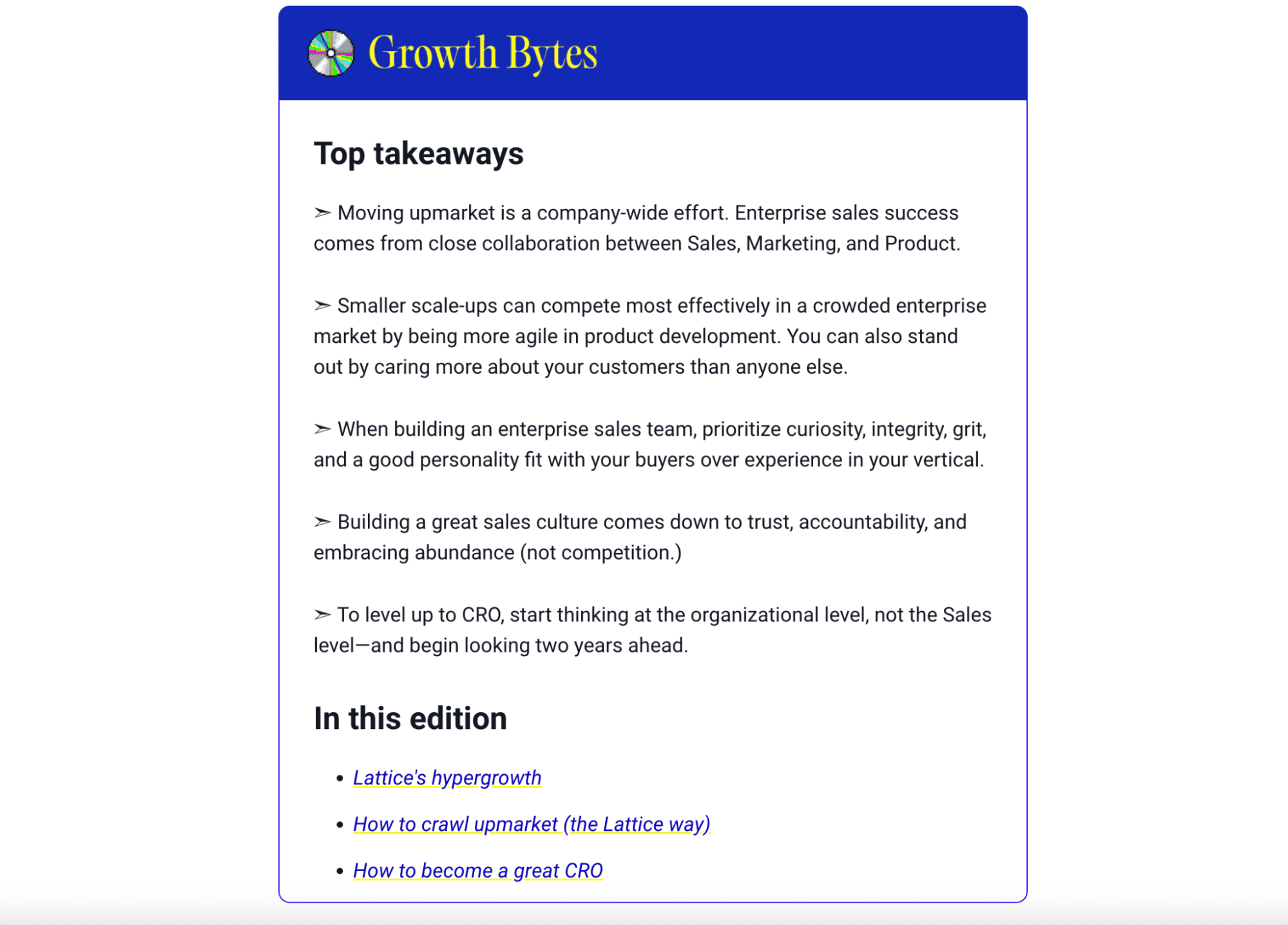
- SME quotes or paraphrased insights
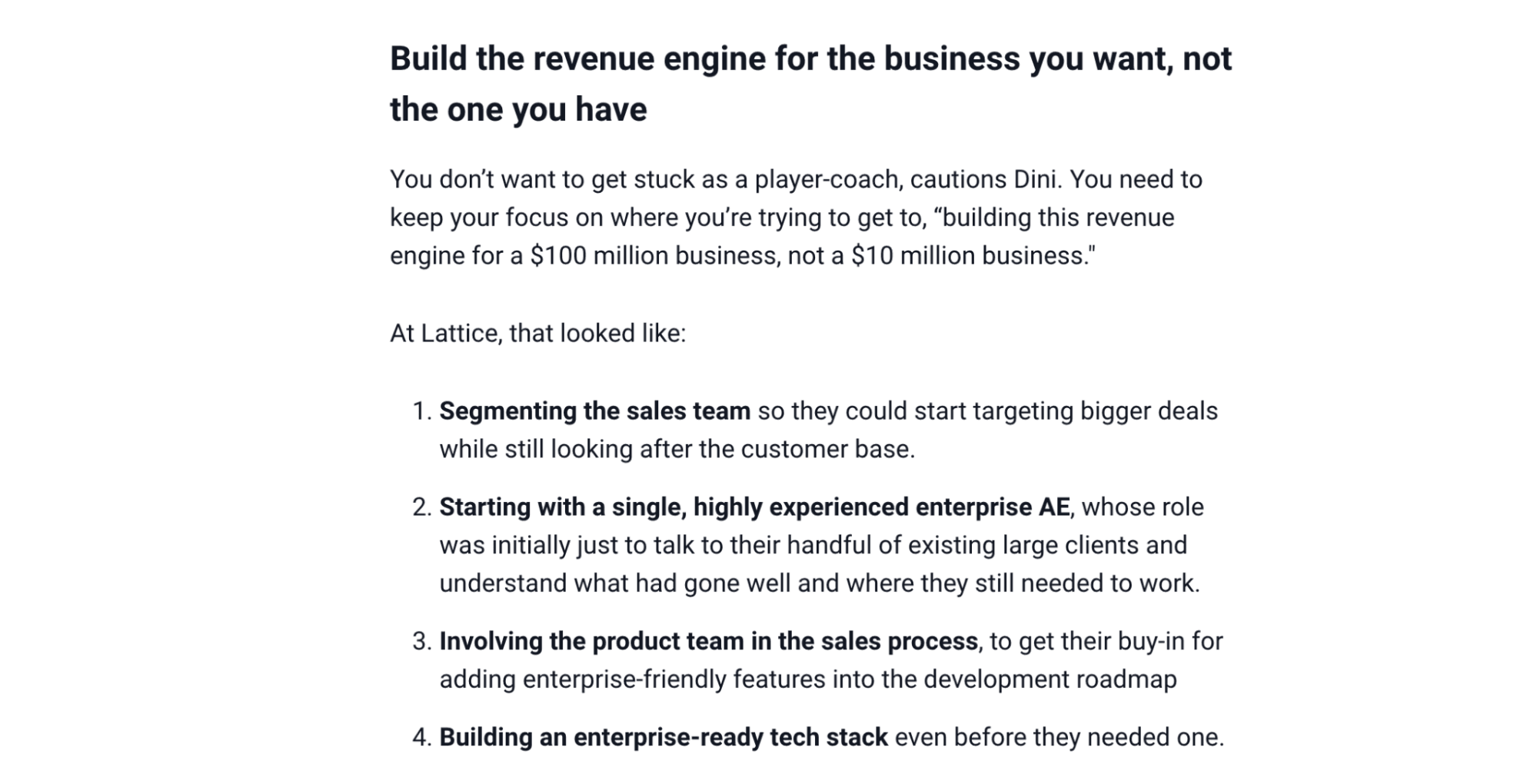
- Embedded clip or visual
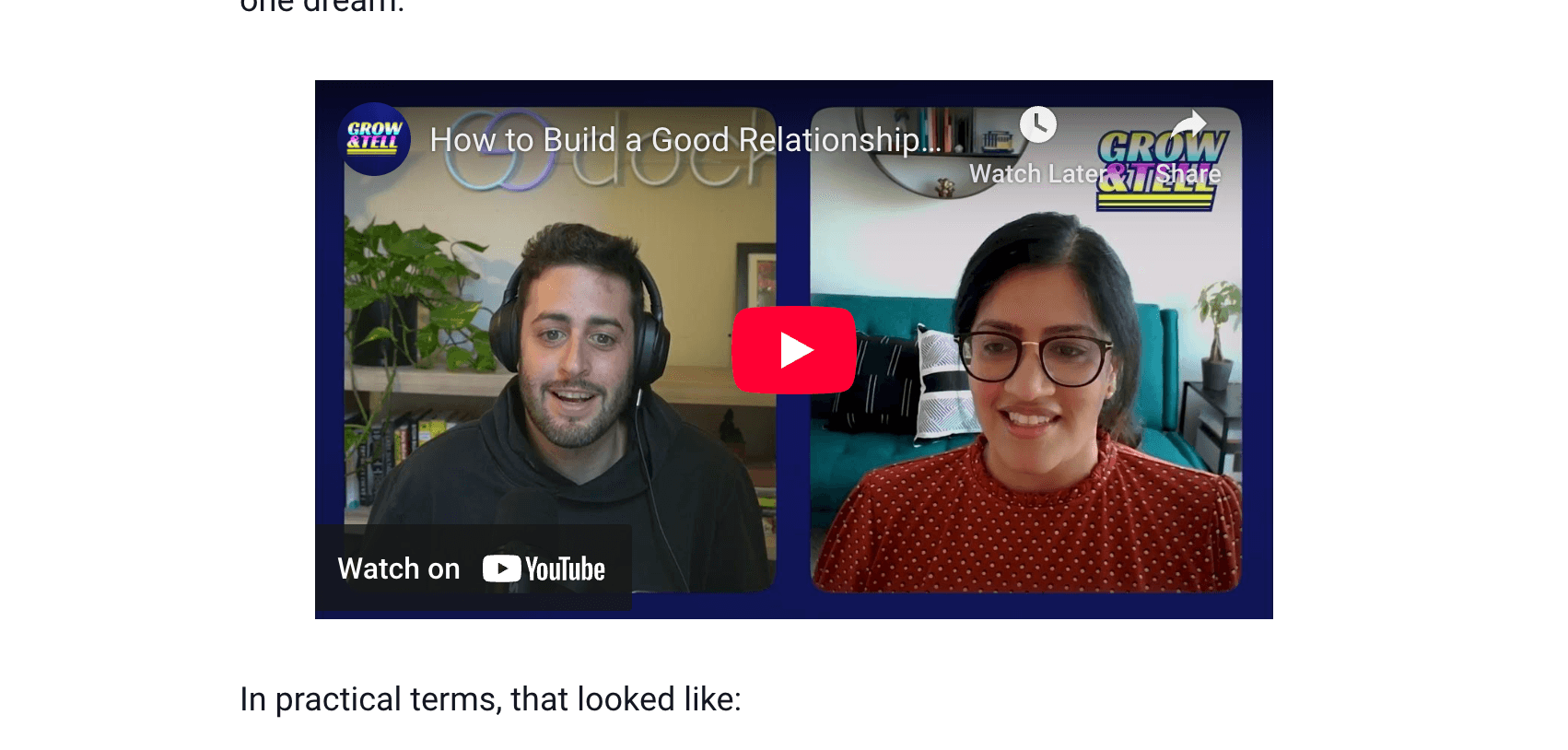
- CTA
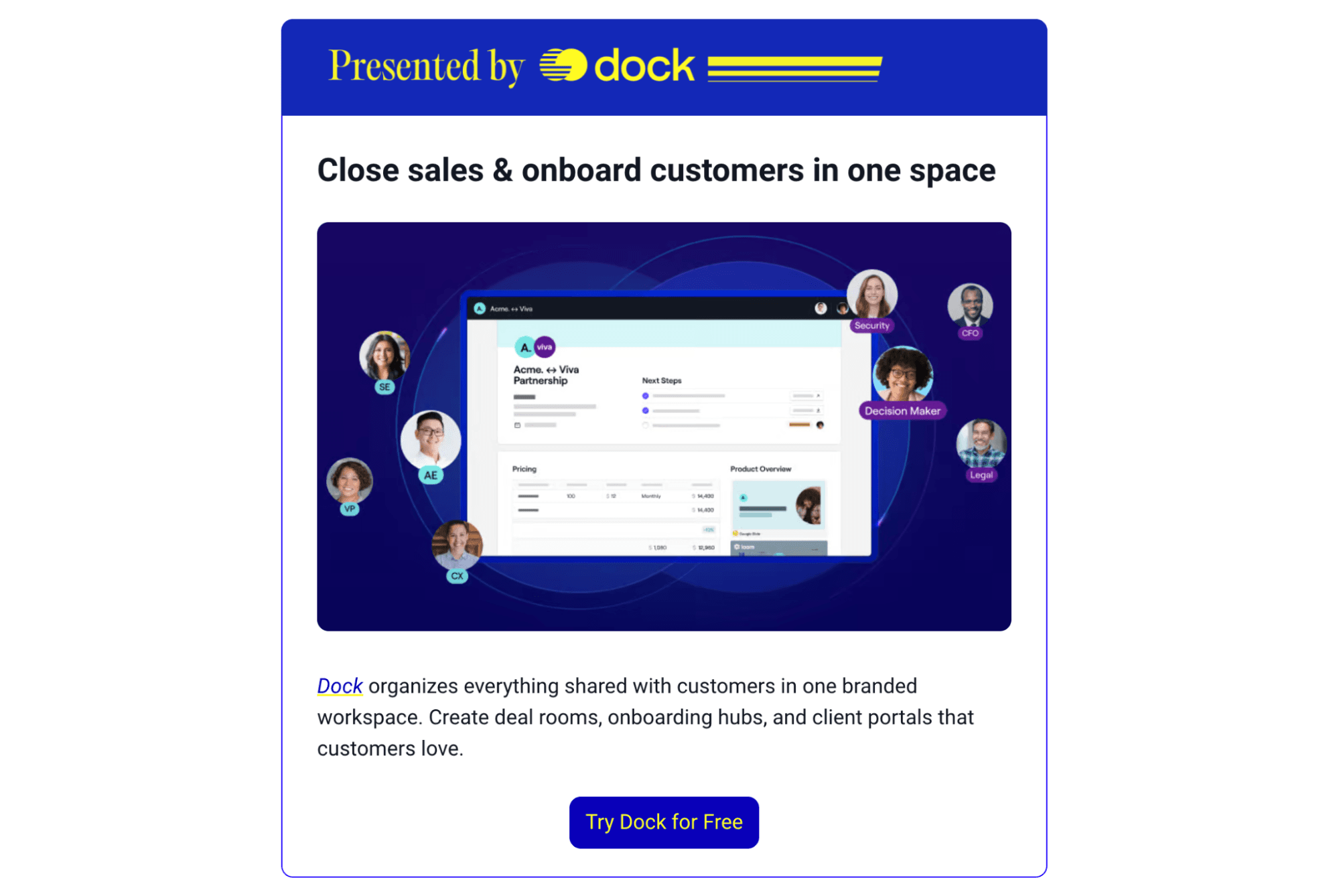
Pro tip: Eric organizes Dock’s interview archive in Airtable “so it’s easy to move those insights into other formats — whether it’s a blog, a newsletter, or something else.”
Once this system is in place, you pull from what you already have like a customer interview or webinar recording and stay consistent without burning out your team.
Drive traffic with easy social media strategies
Now that your expert-driven content is live, the next step is getting it seen by the right people. Influencers, SMEs, and execs all become distribution channels — if you make it easy for them.
These tactics help you build a lightweight strategy that scales with your content.
Break the asset into angles
Slice your content into themes that map to what different audiences care about (e.g., “Top 3 AI insights for B2B marketers” or “What content teams are really burned out about”).
Tommy structured The State of (Dis)Content into three distinct themes: audience research, AI, and career satisfaction. Then, he matched each section to a distribution partner whose audience aligned with the theme.
That structure gave each contact a compelling reason to share without needing to promote the whole asset.
Personalize share prompts for contributors
Make it easy for SMEs, executives, or collaborators to amplify it. Send them:
- One to two talking points tailored to their angle
- A graph or quote they’re featured in
- A pre-written LinkedIn post or email blurb (optional)
Tommy is planning to introduce launch kits for future versions of the same report.
“I’m going to have a little launch kit, where it’s like, here are the top graphs that would be relevant to you.”
The more friction you remove, the more likely SMEs are to share.
Share from multiple voices — not just the brand
Equip executives, contributors, and SMEs with ready-to-share assets they’ll actually want to post — quotes, slides, or social-first takes in their own voice.
This approach works especially well when you're collaborating with busy SMEs, coordinating a big launch, or need quick amplification without asking for extra time or custom content.
Look at the 2025 Sprout Social Index launch. Instead of a single brand announcement, contributors like Brianna Doe and Arielle Berlinsky shared carousel posts with Sprout-branded designs that highlighted their own insights from the report.
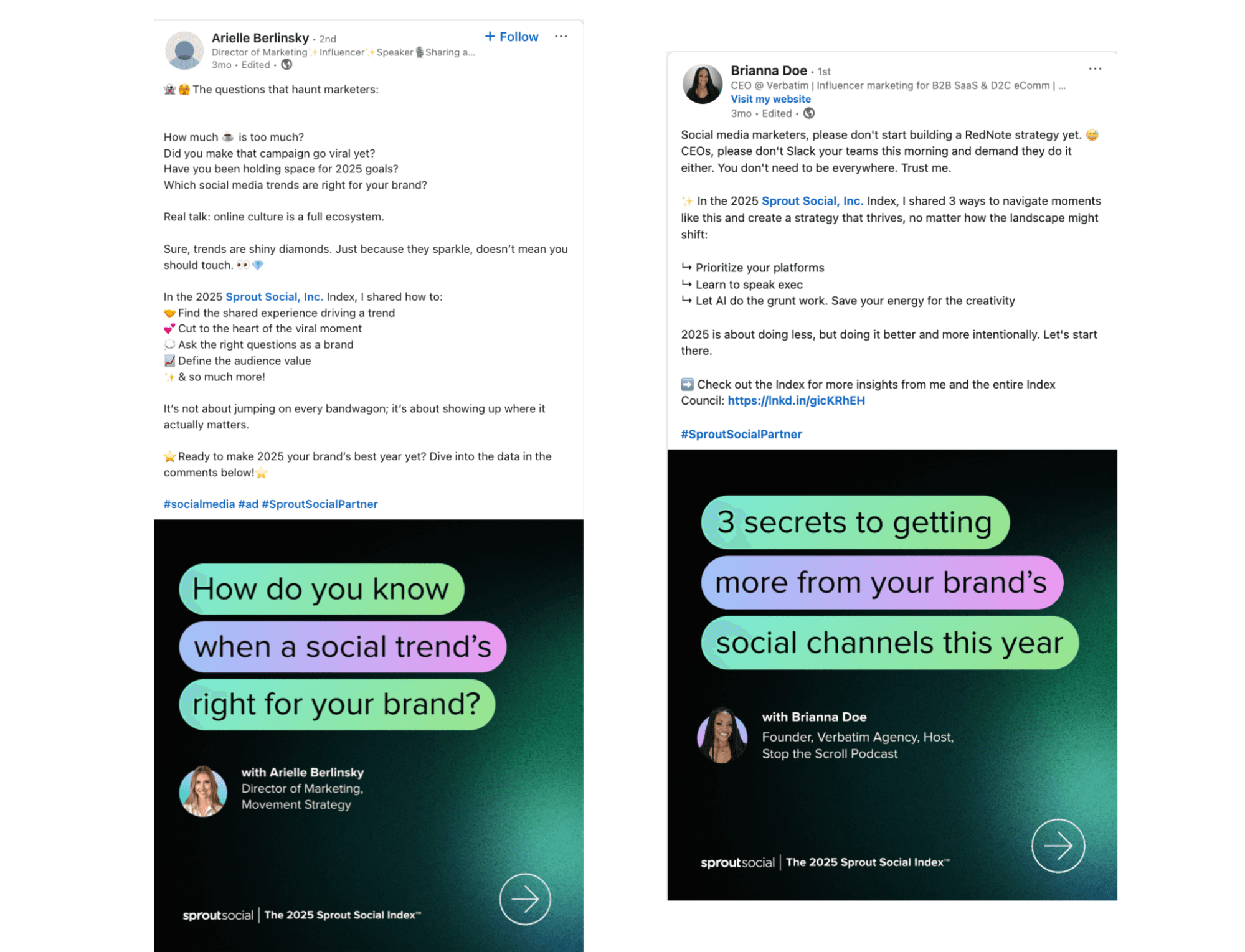
Because they’d contributed to the research, their posts felt like extensions of the work.
But it’s not just external contributors who can drive distribution.
David Baum, founder of Relato, treats the internal editorial team like SMEs and gives them creative ownership over the content they produce.
“Offering the team an opportunity to be heard dramatically increases the likelihood of each contributor sharing the result,” he says. “Encouraging clear opinions and strong points of view has distribution built in. Done well, brands can grow much stronger as a platform for diverse authorship than as a single source of opinion.”
The more ownership each contributor feels — whether they're internal or external — the more authentic (and effective) your distribution becomes.
“Offering the team an opportunity to be heard dramatically increases the likelihood of each contributor sharing the result.”
Template: Promo calendar for gated assets
Front-load the first two weeks, then taper into lighter touch reminders. That keeps the report top of mind without fatiguing your feed or letting it fizzle too early.
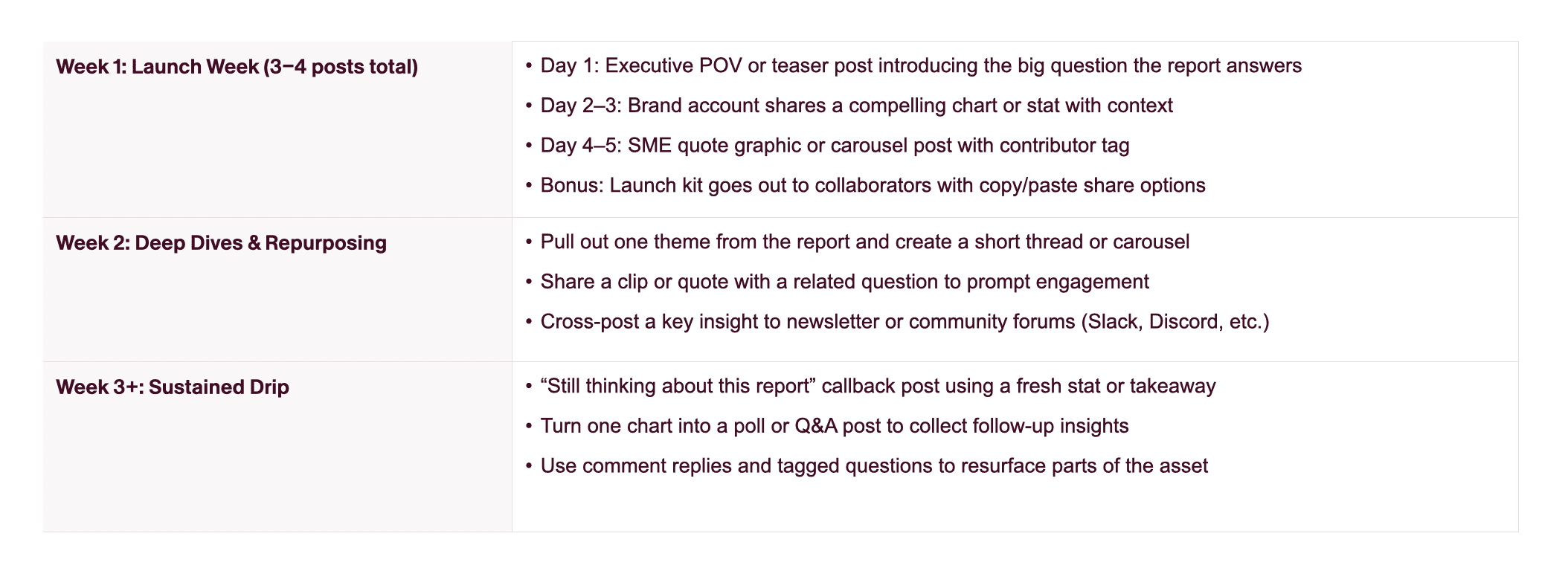
Test influencer partnerships without blowing your budget
Rather than going all-in on a big-budget, long-term influencer campaign to see what works, test influencer content like an experiment.
The goal is to confirm whether a specific voice can spark interest, build trust, or move someone closer to a buying conversation.
Start by identifying three to five creators who:
- Already talk about your category or problem space
- Are active on the platforms where your ICP hangs out
- Have a tone and format that aligns with your brand
Then, scope a lightweight test campaign — something that doesn’t require a contract, a creative brief, or weeks of approvals.
Try:
- Dropping a soft plug in one of their existing posts
- Tagging your brand in a workflow or tooltip post
- Mentioning your product in a Slack-relevant community thread
These formats don’t require scripting or co-creating polished assets. They simply let you test reach and relevance in the creator’s natural voice.
What works best? Ask them what they would naturally say or post. You’re not commissioning content — you’re validating alignment. If their voice resonates with your audience and leads to any positive lift (traffic, shares, sales mentions), then you have a reason to deepen the relationship.
Keep the barrier low, the tracking light (UTM or just anecdotal feedback), and the ask crystal clear. If you wouldn’t share it yourself, don’t ask them to.
Measure influencer campaign success
Measuring influencer impact in B2B isn’t always clean, but it doesn’t have to be vague.
Start with qualitative (sales mentions), add directional (traffic), then confirm with conversion data (email leads).
- Cost per email (CPE): If the goal is lead gen, track how much you're paying per verified email from an influencer campaign.
- Sales call mentions: Ask your sales team: are specific names, posts, or platforms coming up in conversations? Anecdotal? Yes. But when it starts repeating, it’s a pattern.
- Influencer-driven traffic: UTM-tagged links still matter — especially if you’re using gated content. Look beyond click volume to time on page and conversion quality.
- Content saves or reposts (especially on LinkedIn/Instagram): Likes are fleeting. Saves and shares show that people see the content as valuable enough to revisit or recommend.
“If you look at a post that only got 40-ish reactions, but those include VPs and directors from companies like Casper, Nike, and Made In Cookware, that’s a meaningful signal.”
Ryan focuses on the quality of engagement at Modash.
“If you look at a post that only got 40-ish reactions, but those include VPs and directors from companies like Casper, Nike, and Made In Cookware, that’s a meaningful signal.”
He looks at broader customer acquisition cost (CAC) trends and influence over time, knowing that high-consideration tools need multiple touchpoints.
But not every content ROI signal shows up in analytics. Sometimes, the most meaningful validation is organic social proof from the SME themselves.
As David puts it:
“I always celebrate a victory when an SME shares our content with their peers. It’s the ultimate validation for a publisher because it signals that we have succeeded as a platform for discourse. We can always have a point of view as the brand, but it can’t be the only one.”
Because long-term success is about building brand salience with the people who matter most before they’re ready to buy.
Build once, scale everywhere
When you organize your SME strategy right — from picking the right voices to structuring insights for reuse — you stop chasing content deadlines and start building momentum.
Instead of constantly creating from scratch, you’re running a system that feeds your blogs, gated assets, newsletters, social posts, and influencer campaigns, all while staying sharply aligned with what your audience cares about.
Relato helps make this system even easier.
With centralized workflows, built-in approvals, and organized content libraries, you can turn a single SME interview into a steady stream of high-impact assets.
👉 Ready to turn expert insights into consistent content output? Book a demo with Relato today.